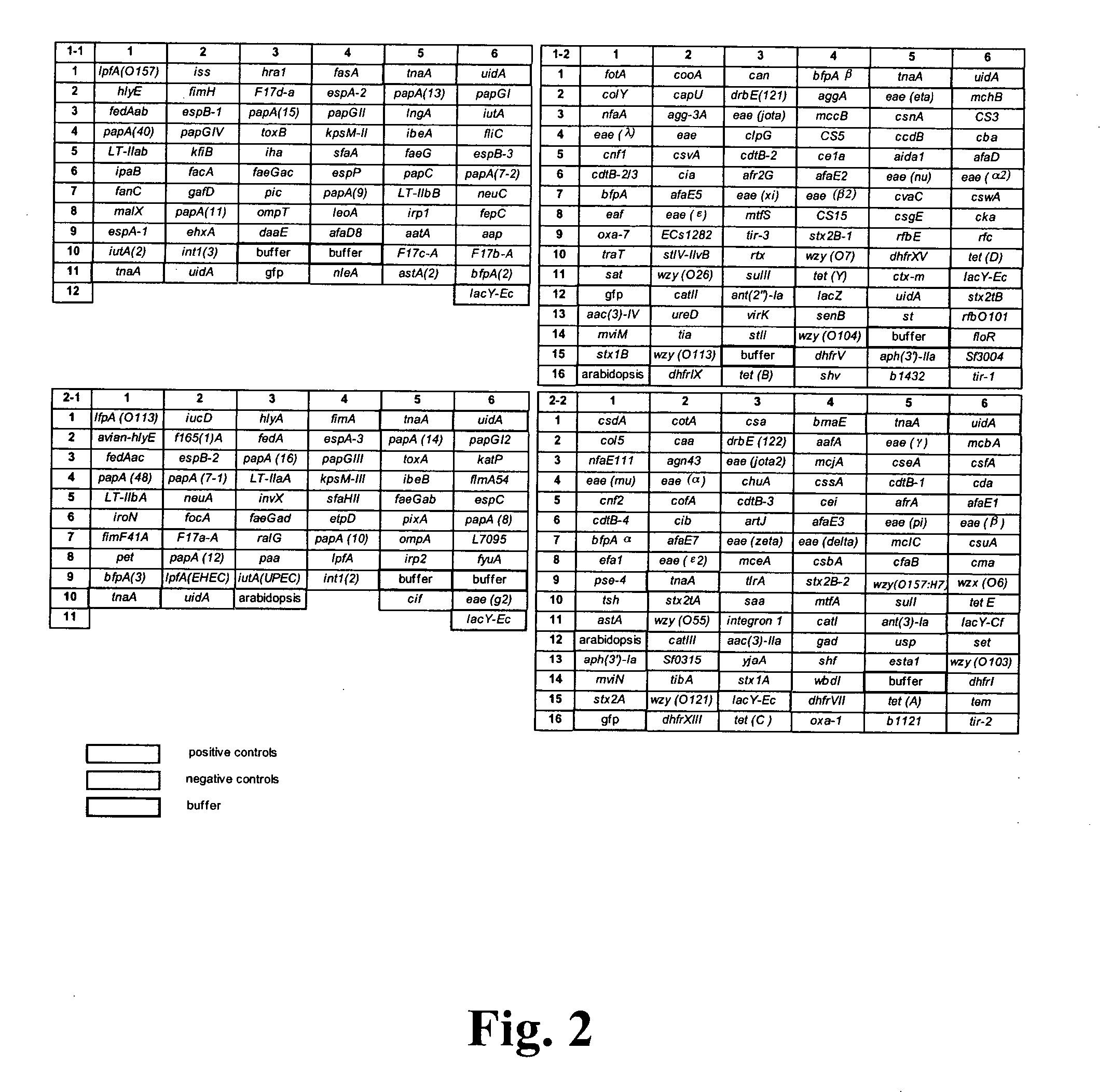Virulence and antibiotic resistance array and uses thereof
a technology of antibiotic resistance and array, applied in the field of array, can solve the problems of no practical, cost-effective way to quickly determine, no technology is offered to rapidly and simultaneously detect many resistance genes and mutations in a single step, etc., and achieves the effects of improving reliability, reducing cost and increasing flexibility
- Summary
- Abstract
- Description
- Claims
- Application Information
AI Technical Summary
Benefits of technology
Problems solved by technology
Method used
Image
Examples
example i
Strains and Media
[0089]E. coli strains used to produce PCR templates are listed in Table 2. E. coli isolates including characterized strains (the non-pathogenic K12-derived E. coli strain DH5α, the enterohemorrhagic strain EDL933, the uropathogenic strain J96, the enterotoxigenic strain H-10407 and the enteropathogenic strains E2348 / 69 and P86-1390) and uncharacterized clinical strains from bovine (B00-4830, B99-4297), avian (Av01-4156), canine (Ca01-E179) and human (H87-5406) origin were used to assess the detection thresholds and hybridization specificity of the virulence microarray. Most of the E. coli strains were obtained from the Escherichia coli laboratory collection at the Faculté de médecine vétérinaire of the Université de Montreal. E. coli strains A22, AL851, C248 were kindly provided by Carl Marrs (University of Michigan) and IA2 by J. R. Johnson (University of Minnesota) respectively. All strains were stored in Luria-Bertani broth (LB [6]) broth plus 25% (v / v) glycero...
example 2
Assessment of the Pathotype Microarray for Virulence Pattern Analysis
[0104] To identify known virulence genes and consequently, the pathotype of the E. coli strain being examined, genomic DNA from several previously characterized E. coli strains was labeled and hybridized to the pathotype microarray. The K12-derived E. coli strain DH5α was included as a nonpathogenic control. Interestingly, E. coli DH5α produced a fluorescent hybridization signal with the uidA, fimA1, fimA2, fimH, ompA, ompT, traT, fliC and iss probes (FIG. 3A). Genbank analysis of the sequenced K12 strain MG1655 genome revealed the presence of the first seven genes whereas the iss probe is 90% similar to ybcU, a gene encoding a bacteriophage lambda Bor protein homolog (sequence K12). Surprisingly, a false positive signal was obtained with the cdt1 and aggA gene probes. These genes are absent in the E. coli K12 genome and their sequences are not homologous to any K12 genes. Moreover, these genes were not positive w...
example 3
Determination of Virulence Patterns of Uncharacterized Clinical E. Coli Strains
[0108] To further validate the pathotype chip, virulence gene detection was assessed by hybridization with genomic DNA from five clinical E. coli strains isolated from human (H87-5406) and animal (Av01-4156, B004830, Ca01-E179, B99-4297) sources. Genomic DNAs from these strains were fragmented and Cy3-labeled and the microarray hybridization patterns obtained were compared with PCR amplification results.
[0109] The virulence gene pattern obtained after microarray hybridization analysis with Cy3-labeled E. coli genomic DNA of avian-origin (Av01-456) showed the presence of the extra-intestinal E. coli virulence genes (iucD, iroN, traT, iut4) and genes present in our K12 strain (fimA1, fimA2, fimH, iss, ompA, and ompt) (FIG. 4A). The temperature-sensitive hemagglutinin gene (tsh) that was often located on the ColV virulence plasmid in avian-pathogenic E. coli (APEC) was also detected on the Av01-4156 virule...
PUM
| Property | Measurement | Unit |
|---|---|---|
| Temperature | aaaaa | aaaaa |
| Fraction | aaaaa | aaaaa |
| Strain point | aaaaa | aaaaa |
Abstract
Description
Claims
Application Information
 Login to View More
Login to View More - R&D
- Intellectual Property
- Life Sciences
- Materials
- Tech Scout
- Unparalleled Data Quality
- Higher Quality Content
- 60% Fewer Hallucinations
Browse by: Latest US Patents, China's latest patents, Technical Efficacy Thesaurus, Application Domain, Technology Topic, Popular Technical Reports.
© 2025 PatSnap. All rights reserved.Legal|Privacy policy|Modern Slavery Act Transparency Statement|Sitemap|About US| Contact US: help@patsnap.com



